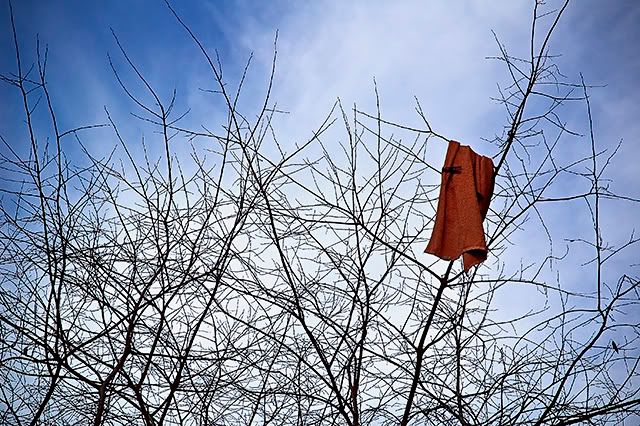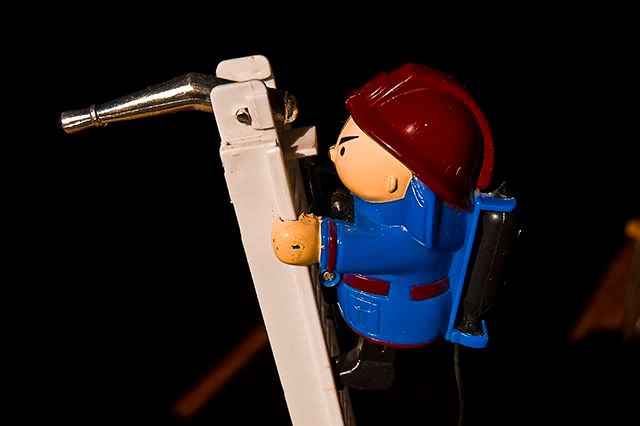Barcelona photos: Daily photographs of Barcelona, Spain. Pictures of a modern city with travel tips in a personal photoblog. A photography and travel site. Art, architecture, people and traditions. Travel to Barcelona through my camera, know more about our city and towns nearby. Welcome!
Wanna be featured?
▼
March 31, 2008
March 30, 2008
Voigtlander: My Vintage Camera

I published a similar picture in the past. This time you can also see the lid in my vintage Voigtländer.
March 29, 2008
March 28, 2008
Escriba's Desserts
![Escriba's Desserts [enlarge]](https://i63.photobucket.com/albums/h135/carloslorenzo/EscribasDesserts_.jpg)
Escriba's: A restaurant by the beach in Barcelona. Here is a sample of what kind of desserts you can have while enjoying the view. Check Xiringuito Escriba
March 27, 2008
March 26, 2008
Baby Rabbits in Nest at a Farm in Vallverd, Lleida
Although Barcelona pictures are in high demand, especially buildings or street photos, I remind you that this blog is always open to other topics that may seem irrelevant sometimes. Such is the case of flowers, assorted objects or animals I find along the way. Moreover, as specified in the description on top there is the possibility of including neighboring towns and by that I mean any place in Catalonia i.e. the Spanish authonomy or the country (according to the political thoughts of its inhabitants) of which Barcelona is the capital. Once said that I wanted to show you a nest of baby rabbits in a small friend's farm in Vallverd, Lleida (map), one of the four Catalan provinces. Everyone knows rabbits but all of them together waiting for mummy in the cage next door to feed them seemed cute enough to portray and a way to shake you off the architectural hypnosis I exposed you to in the last posts.
March 25, 2008
The New Trees of Catalonia
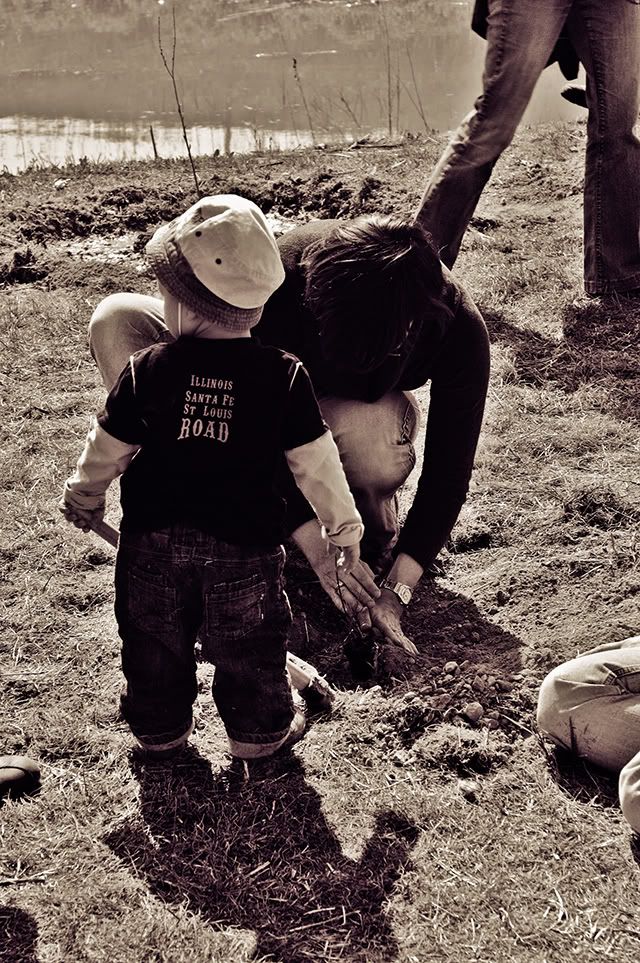
I don't like the final result in this picture because of the strong midday sun and the original colors but I kind of enjoy the pose of the little boy holding a hoe in front of the hole he dug himself and how he waits for his mom to plant the new tree they both had brought to the pond of Ivars (Lleida) as part of a campaign to bring back some green to the barren lands of this country. Well in fact it is customary in many regions of Catalonia to plant trees at the beginning of spring. I would say that in general we care about the environment and children are taught to love nature since they are very young.
March 24, 2008
La Pedrera or Casa Mila, Barcelona, Spain

As you know this is Casa Milá aka La Pedrera by Antoni Gaudi.
I can't say much but I recommend you visit previous posts about the art nouveau building at Passeig de Gracia.
I have tried different angles of the house but this one taken at sunset looked fine enough. Nevertheless I have polarized the façade and added some dramatic sky just out of pure boredom.
I think it is a building that works when it comes to tweaking reality. Here are some other shots from my archives: Casa Mila, Door Ironwork, La Pedrera in BW and La Pedrera a Barcelona Landmark.
March 23, 2008
Obelisk at the Intersection of Passeig de Gracia and Diagonal, Barcelona, Spain
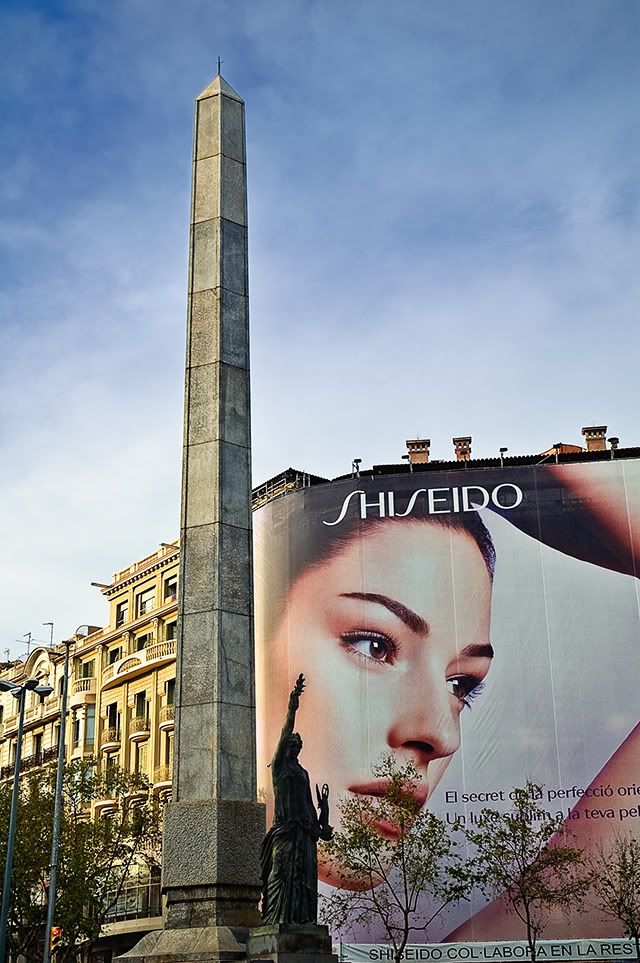
This obelisk you find at the intersection of two main arteries in Barcelona, Passeig de Gracia and Diagonal. Known as the Lápiz (the pencil) it is located on the center of a quite peculiar crossroad that goes by the name of Cinc d'Oros (Five of golds, that is, the golden coins, one of the suits in the Baraja Española or Spanish cards) due to four lamp posts that used to surround the monument. The sculpture represents Franco's victory and dates back from 1940 (I can't believe it is still there considering what it represents!). Well the woman was sculpted by Frederic Marès. It must be said that the original statue (1936), by Josep Viladomat, was dedicated to the Republic, the lady was wearing no robe and instead of being on the present pedestal it was standing on top of the obelisk. Most of all, I enjoyed the combination with the beautiful face in the background, thanks to that the Lápiz looks less boring.
March 22, 2008
The Fountain of the Frog - Sculpture Detail, Diagonal Av., Barcelona
This is a detail of what is known as Font de la Granota (fountain of the frog) on the corner of Diagonal Avenue and Corsega street. You don't see it here but the hands belong to a little boy who is lying on top as if by the bank of a river holding a frog or rather squeezing it to make water pour from its mouth. It was sculpted by Josep Campeny i Santamaria (Igualada, 1858 - Barcelona, 1922) in 1912. To have an idea check this low quality image of the fountain.
March 21, 2008
Modernist Yellow Building at Aribau 179, Barcelona
You don't always need emblematic houses to enjoy great architecture in Barcelona. Sometimes, here and there you find real beauties camouflaged as apartment or office buildings. Standing on Diagonal Avenue and looking down Aribau Street to the right, at Aribau 179 to be exact, you can admire this modest and yet so decorated façade that stands on the very corner illuminated by the last sun rays in this case and looking stately in a way if compared with other not so genuine neighbors.
March 20, 2008
Art Nouveau Balcony at La Diputacio de Barcelona
Just in front of Coqueta, the Giraffe in yesterday's post you find La Diputació de Barcelona, featured in Barcelona Photoblog in the past. Today I just wanted to show you a detail of this wonderful modernist balcony and recommend you go over my description of this government building at Rambla Catalunya: La Diputació de Barcelona
March 19, 2008
Coqueta The Giraffe, A Curious Sculpture at Rambla Catalunya
They say sequels are never better than the original movie. This is the second time that Coqueta, the Giraffe stars in Barcelona Photoblog and I am almost sure this time you'll appreciate its beauty much better. Lots of images in this blog during the first year were taken with a lousy camera and besides there was the well known blogger picture size restriction problem. I did my best then but my gear evolved and so did my photographs. I just hope in the future I am able to give bad reviews about my past work, that would mean everything is getting better. As Socrates said, "true wisdom lies in recognizing one’s own ignorance". In case you want to know more about Coqueta sculpture or Josep Granyer the sculptor please visit my previous posts: Posing Giraffe and Bull by Josep Granyer.
March 18, 2008
Barcelona Roofs: Diagonal Late Modernisme
This roof is rather eclectic, almost as sober as that of a common neoclassic style building but the daring design, the mixture of periods, the Oriental reminiscence in my opinion gives away the Art Nouveau touch that lies beneath. You can admire the architecture of the house if you walk along Diagonal Avenue more or less near Balmes or Enric Granados streets. I don't remember the exact address though.
March 17, 2008
Casa Sayrach: An Art Nouveau Fantasy in Barcelona

Art nouveau buildings are surrounded by mysterious auras that can only be perceived if you are spiritually prepared. The same way auras come in many colors representing different levels of energy or so they say, modernist houses emit some kind of ectoplasm of uncanny origins that seduces, mesmerises those who behold their sinister beauty.
Of course, you've got to have that something in your soul that lets you see things, that ignote power that allows the connection between you, an insignificant end user and the universal stream of knowledge, the legacy of past generations, the richness of human culture and the message that somewhere, someday, another person, an advanced user in this case, left inside a bottle and cast upon the waves of time.
This is Casa Sayrach and the way I see it in my dreams. But let's give some facts about Casa Sayrach: The Sayrach House was built in 1915 by architect Manuel Sayrach i Carreras and it is eclectic in style although it follows modernist schemes, especially those present in Gaudi's works. In fact it is one of the last relevant buildings of the so called late modernist period. The building has been declared of local interest and part of our cultural heritage. It is exactly located on Avinguda Diagonal 423, on the corner with Enric Granados street, on the left side of the Eixample district in Barcelona.
March 16, 2008
Casa Sayrach: The Last Modernist House in Barcelona

This is a detail of Casa Sayrach at Diagonal Avenue 423-425 next to Enric Granados street, one of the best representative houses of late Barcelona Modernisme. Influenced by Gaudi, Manuel Sayrach i Carreras built it in 1918 although the project was signed by Gabriel Borrell. It was restored recently and it is often ignored in traditional routes. The architect didn't have a vast curriculum but was wealthy enough to allow himself every whim. Casa Sayrach is considered to be the last manifestation of Modernisme and that makes it even more relevant. By the way, downstairs on the very corner there is a luxury restaurant called Dama (the Lady) which is a must for gourmets. As today's detail only features the tower I will show another angle including the whole building tomorrow although it appeared in Barcelona Photoblog in the past: Casa Sayrach and here Modernisme in Black and White
March 15, 2008
Artistic Office Building- Carrer Londres 106 - Barcelona
Well the title today says it all. This is just an office building covered with modern paintings in the form of boxes, where orange and red are predominant, clearly visible if you are walking anywhere near the intersection of Diagonal Avenue, Aribau and Londres streets. To be more precise the right address is Londres 106. The boxes are symmetrically displayed on the façade from street level till the highest floors of the building. I added an Indian summer effect to the background to make the paintings stand out a little bit but the colors in the boxes are real.
March 14, 2008
Casa Pérez Samanillo: The Equestrian Club or The Fish Tank?

Built in 1910 by Joan Josep Hervàs i Arizmendi, Casa Pérez Samanillo located at Diagonal Ave. 502-504 (or Balmes 169 bis, as it is at the intersection with this street) is the headquarters of the Equestrian Club (Círculo Ecuestre).
Of Neo-Gothic style this elegant house features an impressive oval window through which you can see the dining room, if you are on a bus or similar of course. Due to its peculiar shape people call it the fish tank.
Even though the Equestrian Club was founded on 26th November of 1856, it was not until 1950 that it was established in its current location. Remember to click on the image for a larger format and better experience.
March 13, 2008
A Gaudian Sculpture Near Sagrada Familia Ceiling
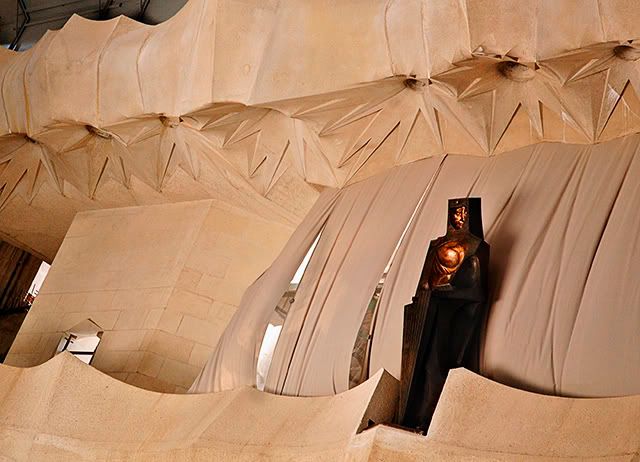
As usual it is hard to crop Gaudi's work. I spotted this weird modernist sculpture near the ceiling at Sagrada Familia. Unlike the ones outside this one is black. I suppose it is some kind of allusion to the Black Virgin called La Moreneta, the patroness of Catalonia but this is just a suggestion of mine.
March 12, 2008
Catalan Traditions: Calçotada. A Close Look

Half way between leeks and onions, there is a plant known in Catalonia as calçot which has become part of our most popular traditions, the calçotada:
According to some sources calçots were first cultivated in XIX by a lonely peasant called Xat de Benaiges in Valls, Tarragona.
In this close shot, you can appreciate the white bulbs that soon will turn completely black on the grill.
Although they can be served on a roof tile, or a common plate, many times you simply pile them up in small amounts and wrap them in newspapers to keep them warm till served. They are quite tasteless, or better said, they taste like onions but without the biting feeling in your tongue. In fact, it is a very soft and delicate flavor that calls for a tasty sauce, in this case, romescu made of ground almonds and hazelnuts, vinegar, olive oil, salt, dry red peppers known as choriceros and paprika.
Don't forget to use a bib to avoid the stains caused by the sauce and keep your fingers away from your clothes. Why so? Well, when you learn about the ritual you'll understand.
- First you spread the newspaper bundles on the table and everybody gathers around, usually standing with a bowl of sauce nearby.
- Now it's time to peel one of them. You take the plant by the leaves and pressing upon the tip of the white bulb with the other hand you try to pull away carefully the burnt out external layer. This you learn with practice. It must come out neatly without smashing the content.
- Then you leave the peel aside (now the hand used for peeling is a mess) and soak the bulb in the sauce, haul it towards your mouth and take a good bite only on the white part of the plant. The rest you throw away.
After this repeat the process at will. Of course, wine is mandatory in this case. Maybe I have been too descriptive today but I have noticed in the past that calçotada details are too often overlooked. Bon appetite!
March 11, 2008
Catalan Food: White Sausages and Spring BBQs
This boiled white sausage ristra I captured with my camera a long time ago but now that Spring is coming and people in Catalonia tend to set out for countryside barbecues, it looks relevant. The sausages or butifarras in this story were cooked during a matanza (pig slaughter) that took place in Lleida, one of Catalonia's provinces. Some more pictures and comments about traditional Catalan cuisine were published here in the past: Blood Sausage and Catalan Sausage
March 10, 2008
Fast Food in Barcelona: KFC at Las Ramblas
As if in some sort of trance or abduction, this man sits over his yummy KFC dinner while he enjoys the view over Las Ramblas, Barcelona. The ubiquitous, almost spooky light reminds me of some painting, you know that one at the late-night diner - Edward Hopper's Nighthawks - I know, it is a hideous comparison. I never was too fond of fast food not even for the Disney presents, that always seemed to me like a kind of blackmail.
March 09, 2008
High Heels - Dancers in Barcelona Streets
Barcelona carnival was over last month but I still have some dancers in stock. Not knowing how to entitled this post I ended up choosing the obvious, those elegant high heels the girl balanced with latin grace.
Useful Link of the Day: 17000+ Photoshop tutorials
March 08, 2008
Cross-Harbor Cable Car in Barcelona, Spain
![Cross-Harbor Cable Car in Barcelona, Spain [enlarge]](https://i63.photobucket.com/albums/h135/carloslorenzo/BarcelonaCableCar_.jpg)
Cross-harbor cable car going from Montjuic Hill (camera point of view) to Sant Sebastia tower (78 mts and second in the background), stopping first at the Jaume I tower (107 mts) next to WTC complex. The towers were built by Carlos Boigas in 1931 after Barcelona Universal Exhibition. Cable cars move about 70 meters above the ground. With a capacity of 19 passengers cabins take 5 minutes to cover the itinerary at an interval of 10 minutes between each other. Prices have changed but they don't exceed 10 euros as of yet.
March 07, 2008
Spring Infatuation: Purple Flowers
Infatuation is defined as a foolish, unreasoning, or extravagant passion or attraction or an object of extravagant, short-lived passion. I couldn't think of a better word to express my mood in front of the color, the design, the equilibrium and symmetry of these insignificant purple flowers announcing the arrival of Spring.
March 06, 2008
Soldier of Fortune - A Human Statue
![Soldier of Fortune - A Human Statue [enlarge]](https://i63.photobucket.com/albums/h135/carloslorenzo/SoldierofFortune_.jpg)
Stop! Hold it there! You miserable, lousy scoundrel. I swear upon my sword that you will not flee from Barcino without tipping me first. Yes, you, what are you staring at? Give me that black box with lightnings inside. Just one miserable denarius? You must be out of your mind? Oh, that's better, euros will be fine. If you missed my previous post about this living statue please visit: Human Statue of Warrior at Las Ramblas de Barcelona.
March 05, 2008
Photo of Yellow Flowers at Ramblas Stall in Barcelona, Spain
A close look on a bunch of yellow flowers, possibly daisies, that remind me of sunflowers in a certain way. I am not a florist or an expert on botany so I leave it up to you to identify the right name. Now that you are with me visiting Las Ramblas flower stalls in Barcelona, why don't you check my whole flower set on Flickr. All of the images together are more luring.
March 04, 2008
CowParade Barcelona: Emdea by Pavel Lagner
More than a year ago I posted Cow Parade Barcelona: Ms. Moolevard on the Boulevard by Amber Felts as captured at Illa Diagonal. Today I feature another great cowparade design this time found at a small shop on the corner of Plaça Sant Jaume and Carrer de la Llibreteria
March 03, 2008
World Hunger, A Political Issue
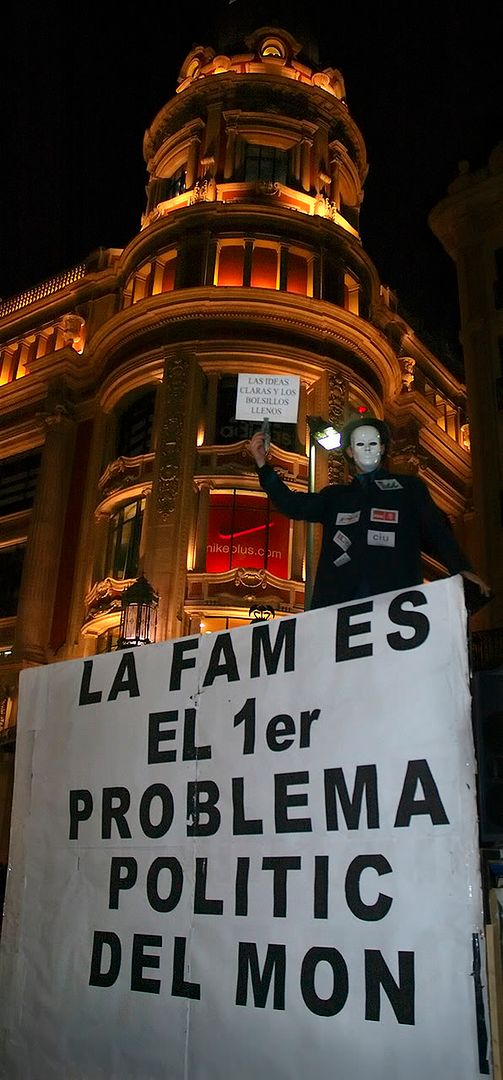
Portal del Angel, the street in Barcelona with the highest price per square meter was the place chosen by this organization to proclaim that La fam es el 1er problema politic del mon (hunger is the world's number one political issue). I thought it was interesting to let old Jorba department store, now owned by El Corte Inglés, Spain's largest department store chain, appear in the background for emphasis. I understand the quality of the picture is poor but I am sure that's out of the question in this case. Check this video about Portal del Angel where you will see the store and the thermometer shown in yesterday's post.
March 02, 2008
Portal del Angel: Can Cottet Thermometer

Back in 1956 a big thermometer was hung on the façade of Can Cottet building at Portal del Angel avenue (the most expensive street in Barcelona). It was customary in the fifties to boast about "new technologies" in public spaces.
Cottet was a famous optician selling specs and shades and I still don't understand what the thermometer had to do with them. But before you leave maybe you would like to know the whole story about Can Cottet thermometer.
The measuring instrument was designed by Rolando Cottet and was installed in 1955, but would not be operational until February 25, 1956. The project was carried out by the architect Pedro Ricard Biot. This thermometer is inspired by a similar luminous thermometer in Copenhagen.
The thermal range of the thermometer goes from 5 degrees below zero to 40 degrees Celsius. The thermometer is placed 4 meters above the ground and rises up to 24 meters . The device weighs two tons.
The Can Cottet thermometer has undergone some remodeling, but always trying to maintain the original external appearance. In 1998 it was renovated, taking advantage of the rehabilitation of the facade of the building. In 2009, its neon tubes were replaced by low-power led lamps. In July 2011 it was granted a "Little landscape of Barcelona" distinction by the Municipal Institute of Urban Landscape and Quality of Life.
March 01, 2008
Shops in Barcelona: Lady Taking a Shower at Ferran Street
A store is a store and I won't surprise anybody with a more or less regular shop window but this one seemed curious enough to show. I don't want to publicize the place for free but I can tell you that it is one of the many tourist shops at carrer Ferran in Barri Gotic (Gothic Quarter). You should also know that such quarter is located in Ciutat Vella district. By the way if you are really a fashion window enthusiast then you ought to check this wonderful collection: Store Windows and Displays
Labels
architecture
(164)
modernisme
(82)
art nouveau
(74)
gaudi
(74)
food
(67)
flowers
(63)
street artist
(55)
sculpture
(48)
barri gotic
(39)
las ramblas
(39)
sagrada familia
(33)
dancers
(29)
beach
(28)
amusement park
(27)
port
(27)
human statue
(26)
art
(25)
mosaic
(25)
tibidabo
(25)
guell
(23)
sant pau
(23)
barcelona streets
(22)
tips
(22)
Catalan traditions
(21)
barcelona shop
(21)
market
(21)
montjuic
(21)
gothic quarter
(19)
domenech i montaner
(18)
la boqueria market
(18)
opinion
(18)
carnival
(17)
christmas
(17)
costa brava
(17)
ciutadella
(16)
maremagnum
(16)
folklore
(15)
classic
(14)
balcony
(13)
modernist
(13)
sea
(13)
street art
(13)
barcelona hotels
(12)
catalan art nouveau
(12)
catalan towns
(12)
costumes
(12)
graffiti
(12)
la pedrera
(12)
stained glass
(12)
casa mila
(11)
casa modernista
(11)
door
(11)
fountain
(11)
history
(11)
barcelona market
(10)
ceiling
(10)
la rambla
(10)
barcelona port
(9)
bikes
(9)
chocolate
(9)
crafts
(9)
paper mache
(9)
pedralbes
(9)
port aventura
(9)
vintage
(9)
architects
(8)
cosmocaixa
(8)
harbor
(8)
hotel
(8)
motorbike
(8)
passeig de gracia
(8)
arc de triomf
(7)
classic cars
(7)
dali
(7)
gracia
(4)
palau de la musica
(4)
accommodation
(3)
barcelona bar
(3)
casa batllo
(2)
cheese
(2)
cruises
(2)
gracia quarter
(2)
ham
(2)
wine
(2)
hostel
(1)
parc guell
(1)
picasso
(1)
